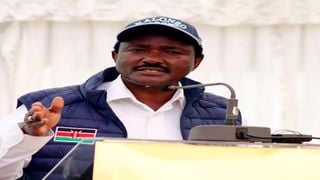
Wiper party leader Kalonzo Musyoka.
| File | Nation Media GroupPolitics
Premium
Why Kalonzo could be kingmaker in the 2022 election
Wiper Party leader Kalonzo Musyoka is being courted by the two main political formations targeting the estimated two million votes in Machakos, Makueni and Kitui counties.
Mr Musyoka, who was Orange Democratic Movement (ODM) leader Raila Odinga’s running mate in the 2013 and 2017 elections, insists he won’t play second fiddle to anyone.
However, analysts say politics is the art of the possible as shown in Mr Musyoka’s backing of Mr Odinga in 2013 despite their acrimonious relation during the grand coalition government.
Mr Musyoka was vice-president while Mr Odinga was prime minister from 2008 to 2013. The ODM side has reached out to Mr Musyoka while Deputy President William Ruto has stepped up campaigns in the former vice-president’s stronghold, asking voters to reject Mr Odinga.
That Mr Musyoka could be the one holding the wild card in the race to succeed President Kenyatta is evident.
The ODM leader’s presidential ambition could suffer a huge setback were he to lose the more than one million votes from the region that bolstered his tally in 2013 and 2017.
For the DP, making significant inroads into Kitui, Makueni and Machakos would improve his fortunes at a time Mr Odinga backed by President Kenyatta is seeking a slice of the Mt Kenya vote bloc the Jubilee leaders have relied on to ward off the opposition.
Wiper vice-chairperson Mutula Kilonzo Jr., argues that Kitui, Machakos and Makueni remain in the grip of Mr Musyoka. He adds that party technocrats have informed Mr Musyoka to fix his eyes on the “winning coalition”.
Winning formula
“For Mr Musyoka, going it alone is not a winning formula,” Mr Kilonzo, who is also the Makueni senator, said.
“Going it alone could come in play if the idea is a second round matrix,” he said.
The senator argued that it’s on the basis of the realisation of how crucial the region is that the president is determined to ensure the former National Super Alliance (Nasa) principals, Mr Odinga, Mr Musyoka, Amani National Congress’ Musalia Mudavadi and Ford Kenya’s Moses Wetang’ula form a coalition.
“Southeastern Kenya is a swing vote that can’t be ignored. It could come in handy as was the case in 2007,” Mr Kilonzo said, referring to Mr Musyoka’s first stint at the presidency that is widely considered to have led to the stalemate between the frontrunners in that contest, President Kibaki and Mr Odinga.
In the ensuing post-poll crisis, President Kibaki named Mr Musyoka vice-president, a development credited to have helped stabilise the ruling Party of National Unity’s government.
It strengthened President Kibaki’s hand in power-sharing negotiations with Mr Odinga, who was later appointed Prime Minister.
Fourteen years later, Mr Musyoka could again play a decisive role in the transition to the country’s fifth president.
ODM chairman, John Mbadi, said the Wiper Party leader cannot be underrated in the country’s political matrix. He said Mr Musyoka remains a player in national politics, especially the 2022 succession race.
“Mr Odinga would not have picked him as a running mate in two successive presidential contest if he were not adding value. He came with a very solid share on the table,” Mr Mbadi told the Nation, adding, the ODM leader’s team is keen to reach out to the former vice-president.
“We are reaching out to many leaders and Mr Musyoka is one of them. You can’t wish him away. Neither can one underrate him.”
The Wiper leader became the undisputed Southeastern Kenya leader when he defied the odds and contested the presidency in 2007, garnering 879,903 votes.
An analysis of his contribution in the subsequent presidential elections shows an upward streak, meaning he has maintained the grip on his support base.
Vote basket
It is estimated that Mr Musyoka delivered 1.3 million to 1.5 million votes to Mr Odinga’s vote basket in 2013 and 2017.
Kitui, Makueni and Machakos, which form Mr Musyoka’s political base, delivered 900,405 votes out of the 1,068,684 who had registered in 2013.
Though the 2017 presidential poll results were nullified by the Supreme Court, the figures the Independent Electoral and Boundaries Commission (IEBC) had apportioned to Mr Odinga from the three counties provide a clue on Mr Musyoka’s relevance in national politics.
The ODM leader received 968,437 votes from the three counties that had more than 1.5 million registered voters in 2017.
It is projected that the three counties have more than 770, 000 potential new voters that could raise the region’s tally to over two million.
That the Kamba community has a significant vote in Nairobi, Mombasa, Kwale and Taita Taveta counties is not in dispute.
Regional supremacy
Data published by the IEBC in 2013 showed that with 15 per cent, the Kamba vote was the third largest in Mombasa after the Miji Kenda (29 per cent) and Luo (17 per cent).
The community has a huge presence in Changamwe and Jomvu constituencies, Mombasa, Kwale and Taita Taveta there are elected ward representatives.
Governors Charity Ngilu (Kitui), Alfred Mutua (Machakos) and Kivutha Kibwana (Makueni) and a host of other leaders have persistently challenged Mr Musyoka for regional supremacy but he has always prevailed.





